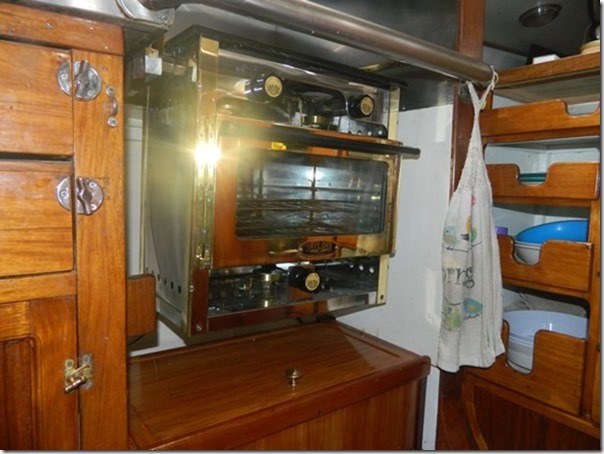Wild Weather and Willful Cookers

|
Position: Alongside RSAYS,
Adelaide As most of you are likely aware, South Australia went into a snap lockdown on Tuesday evening. For the most part it has not effected me too much. Work on Sylph’s deck has commenced with a few rust spots welded up on the foredeck in between bouts of wet and windy weather. They have been primed and faired and just need some additional coats of paint when we get some more dry spells. And last Friday we took delivery of a long awaited new stove-oven. It is a classic Taylor’s kerosene model and I am a little embarrassed as to how much I paid for it (quite a bit more than I paid for the canary yellow hatchback). In some ways it is a reversion to things older and arguably requiring yet more maintenance; however, there are a number of reasons I have been prepared to pay the price for a Taylor’s marine cooker. First and foremost is that kerosene is so much safer than LPG – it might catch fire but it will never blow you and the boat to Kingdom come as LPG can do if one isn’t very careful. The other major reason is the simplicity of carrying a fuel that is liquid at room temperature – one doesn’t need to lug heavy gas bottles around, which different countries have different standards for, requiring different bottles and different regulators depending on which country one is in. Despite these drawbacks, I have done my best to make LPG work on Sylph but I have never been satisfied with the set up. Ugly gas bottles on deck do not fit well with Sylph’s low freeboard and classic sheer. There is no where I can fit them on deck without waves in heavy weather threatening to wash them over the side. Consequently, I have fitted them in the lazarette. I made the lazarette bulkhead gas tight (I think) and installed a drain over the side; however, again because of Syph’s low freeboard, when sailing the drain tends to let water into the lazarette rather then gas out. I also installed dual gas alarms, an automatic solenoid shut-off valve, and a vent to allow fresh air to circulate into the lazarette but this also just lets water into the lazarette in heavy weather. Then there is the problem of changing over gas bottles when at sea, not to mention the problem of not being able to have a HF radio aerial running through the lazarette. The list of problems goes on. So, the obvious solution seemed to me to be to revert to kerosene. I originally installed a kerosene cooker when I purchased Sylph, an Australian made Broadwater model, but it was not very well engineered and changing over burners was something of a nightmare. The Taylor has a much better system (I won’t bore you with the details). Come last Friday when I at last received the new (actually old refurbished) cooker I was quite excited to start fitting it. To do so was a bit of a commitment as it required removal of the old stove-oven and once that was done, if I had any problems, I was going to be eating cold baked beans for dinner. I wish I could say that the installation was trouble free but that was not the case. It all gets a bit technical from here and I do not want to bore everyone more than I already have. Suffice to say that I got the cooker working but with a few problems. One being a slight leak in the join between the fuel filter and the flexible hose to the cooker and another being that I have managed to damage a burner so have only one stove burner and the oven burner operational. I hope to solve the leak tomorrow (Monday) when I can purchase new compression fittings and install the fuel filter properly. Also, I will have to order some more parts from Taylors in England. Bother! Still, in a glass half full attitude, two out of three burners are working. I managed to cook a very satisfactory pizza in the oven last night and tonight I have the pressure cooker simmering away on the stove burner. The sweet aroma of curry fills the saloon. All is well.
|
